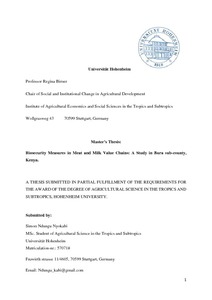Resource information
Livestock value chains are an important source of employment, income and nutrition in developing countries. Increasing income has led to high demand for animal source products. Zoonotic diseases pose a public health risk to people producing, handling, processing and consuming animal products; with value chains creating a contact networks for transmission. Biosecurity measures constitute a cheap, integrated approach and affordable way of disease control from farm to fork as advocated by the concept of ‘One Health’ and ‘EcoHealth’.
This research used mixed methods - qualitative and quantitative methods. A semi-structured questionnaire was used to test knowledge, attitude and practices of value chain actors. Sampling techniques used included snowballing and convenience sampling in markets days as no register of actors existed, aiming to reach as many actors as possible.
Participatory mapping exercises were utilised to map activities and biosecurity measures in the value chain and evaluate occupational risk, biosecurity measures adopted and drivers of adoption. This was complemented with key informant interviews conducted with key actors including government institutions employees.
Results indicate low knowledge of diseases, symptoms and biosecurity measures among value chain actors reflected by low adoption of biosecurity measures. Poor handling of food products exist, which increases the risk of contamination and at the same time exposes actors’ to diseases. There is non-enforcement of laws, inadequate extension services, governance challenges and low institutional support for actors to implement and adopt biosecurity measures. Qualitative analysis or risks highlighted many gaps that need to be addressed urgently.
Risks associated with milk and meat safety hazards require a cooperative approach of the value chain as a whole (from farmers, meat processors and consumers to government authorities) as a lapse at any point of the value chain (inspection, processing, distribution and meal preparation) poses a risk to human health as well as environmental and animal health (Butler et al. 2003; FAO 2011).


